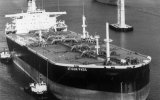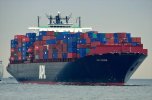You are using an out of date browser. It may not display this or other websites correctly.
You should upgrade or use an alternative browser.
You should upgrade or use an alternative browser.
It's been a rough winter in the Pacific..
- Thread starter deepdraft1
- Start date
I have sailed in rough seas in all kinds of vessels. While cargo may not be lost (other than a broken tow wire) by tugs, bouncing around in 45+ seas in a 160' long tug boat is its own special pleasure. Unfortunately, I don't have any pictures of that kind of fun. Was too busy just hanging on. . . .At least in that particular instance, we didn't loose the tow. . . an SL-7. Here is a photo in calm seas.I don't either brother..
Early in my career I sailed 2nd and 3rd Mate on Keystone and Trinidad tankers going up to Valdez.. Not a whole lot of fun in the winter time.. I remember one winter sailing loaded from Valdez for Cherry Point when rough seas peeled a breakwater right off the deck just forward of the manifold piping.. In early December a few years later I made my first trip as Master sailing on a containership from Seattle to Dutch Harbor and then on to the Far East. As soon as I got outside and clear of Cape Flattery it seemed as if the whole Pacific Ocean was coming at me..
View attachment 7960
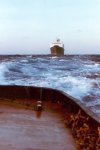
- Joined
- Jun 21, 2018
- Messages
- 1,587
I could only imagine being is real heavy seas on a tug. Wet for sure.I have sailed in rough seas in all kinds of vessels. While cargo may not be lost (other than a broken tow wire) by tugs, bouncing around in 45+ seas in a 160' long tug boat is its own special pleasure. Unfortunately, I don't have any pictures of that kind of fun. Was too busy just hanging on. . . .At least in that particular instance, we didn't loose the tow. . . an SL-7. Here is a photo in calm seas. View attachment 7965
Or The Perfect StormI think it's best my mom not see this post. Lol Reminds me of something from the show Deadliest Catch.
So do they only keep the refrigerated containers below deck?Deck cadets who are on container ships during sea year are expected to go below deck (6-10 stories) and check on containers. The temperature of each refrigerated container has to be checked regularly to make sure there are no malfunctions. One of my biggest worries as a mom during sea year was high seas shifting containers and squishing my kid.
- Joined
- Jun 21, 2018
- Messages
- 1,587
18 years of sailing tankers world wide. Worst storm was outside Prince William Sound. 240KDWT tanker, blinding horizontal snow, we estimated the seas at 80-90 Ft. Bridge wing was 120 ft. Ht. of eye above water. Professional mariners typically under estimate wave heights. We were hove too, making sternway, engine ahead about 20 RPM (If I recall right). Lights on in the wheel house during night - because you could not see 3 feet anyway! Not fun. No major damage! I guess the fetch, wind waves & sea swell was just right to build to that level. I think this was about 1994 ish. A couple if sick crew members though. I never expieence seas like that again. 40 or 50 ft. is bad.
- Joined
- Jun 21, 2018
- Messages
- 1,587
I have very little underway time on a warship. With the finer lines (block coefficient), they must go under water in real heavy seas.
- Joined
- Jan 21, 2009
- Messages
- 647
No. I've seen reefers stowed as high as the 4th tier on the hatch lids.. Here's a picture of a 3 high stack of reefers on the hatch of an APL C-11 class containership.. the reefer boxes you see up 5 high were not active.. They were either empties or were 'dry' loads.. The rust red catwalk structure aft of the first tier of containers is known as a lashing bridge.So do they only keep the refrigerated containers below deck?
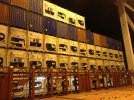
DRMbig2024
Member
- Joined
- Nov 21, 2019
- Messages
- 31
Okay I try to follow your conversations but it's difficult as a mom with Zero boat knowledge so when you say things like 240KDWT tanker or APL C-11 class - I have no idea what you are talking about. However, I'm sorry because when you said reefer stowed as high as the 4th tier, I had another thought and had to google it so if anyone else is wondering what a reefer is: A REEFER CONTAINER is a short form for REFRIGERATED CONTAINER. Simply put, reefer containers are big fridges that are used to transport temperature controlled cargoes such as fruits, meat, fish, seafood, vegetables, dairy and also also non-food products such as flowers, pharmaceuticals and film across many miles and oceans.. LOL -Learning!
@DRMbig2024 and others, keep reading and studying and you will learn. Your incentive is that when your mids are in sea year, you will actually be able to understand them when they talk to you about their experiences. Without any prior knowledge or experience in the shipping industry, we obviously cannot know what it is like out there, but we can understand enough to ask good questions and appreciate at least to some extent when we hear all the amazing sea stories they will have. Keep the faith.
- Joined
- Sep 27, 2008
- Messages
- 24,756
More on “Reefer Madness”: 

As Navy people, we have a reefer in our kitchen. We also have a reefer in our garage. The cold kind we store perishables in, not the inhalable kind. The reefers on ships are big containers. The ones in restaurants are walk-in. You can also have a wine reefer.
As retired Navy officers, we still have our officer reefer short heavy wool coat, which is the parallel version of an enlisted sailor’s peacoat. The officer coat has gold crest buttons and a place for rank shoulder boards. When I retired from active duty, I replaced the gold buttons on that reefer with plain ones, except for one gold button hidden way up high under the collar. Still one of my warmest coats.
Return to professional discussion.
As Navy people, we have a reefer in our kitchen. We also have a reefer in our garage. The cold kind we store perishables in, not the inhalable kind. The reefers on ships are big containers. The ones in restaurants are walk-in. You can also have a wine reefer.
As retired Navy officers, we still have our officer reefer short heavy wool coat, which is the parallel version of an enlisted sailor’s peacoat. The officer coat has gold crest buttons and a place for rank shoulder boards. When I retired from active duty, I replaced the gold buttons on that reefer with plain ones, except for one gold button hidden way up high under the collar. Still one of my warmest coats.
Return to professional discussion.
- Joined
- Jan 21, 2009
- Messages
- 647
240KDWT = 240,000 Dead Weight Tons, in other words a 'super tanker' or VLCC [Very Large Crude Carrier].. attached are a couple of picture so you have an idea what we're talking about.. One is the Keystone tanker ATIGUN PASS.. As I recall she was around 200,000 DWT.. The other is a C-11 class containership the APL CHINA.Okay I try to follow your conversations but it's difficult as a mom with Zero boat knowledge so when you say things like 240KDWT tanker or APL C-11 class - I have no idea what you are talking about. However, I'm sorry because when you said reefer stowed as high as the 4th tier, I had another thought and had to google it so if anyone else is wondering what a reefer is: A REEFER CONTAINER is a short form for REFRIGERATED CONTAINER. Simply put, reefer containers are big fridges that are used to transport temperature controlled cargoes such as fruits, meat, fish, seafood, vegetables, dairy and also also non-food products such as flowers, pharmaceuticals and film across many miles and oceans.. LOL -Learning!
Yes, there's a wide variety of commodities that are carried in reefer boxes.. My kid who is currently the Chief Mate on a containership that runs to Northern Europe told me they've been carrying blood plasma, which apparently, due to strict temperature requirements is monitored both by the ships personnel and remotely ashore by the company shipping the stuff.
Attachments
- Joined
- Apr 9, 2017
- Messages
- 10,966
How long would a storm like this last? I cannot imagine18 years of sailing tankers world wide. Worst storm was outside Prince William Sound. 240KDWT tanker, blinding horizontal snow, we estimated the seas at 80-90 Ft. Bridge wing was 120 ft. Ht. of eye above water. Professional mariners typically under estimate wave heights. We were hove too, making sternway, engine ahead about 20 RPM (If I recall right). Lights on in the wheel house during night - because you could not see 3 feet anyway! Not fun. No major damage! I guess the fetch, wind waves & sea swell was just right to build to that level. I think this was about 1994 ish. A couple if sick crew members though. I never expieence seas like that again. 40 or 50 ft. is bad.
- Joined
- Jun 21, 2018
- Messages
- 1,587
To put a 200,000 ship in perspective...this is what she weighs when full of cargo (Oil for an oil tanker). An Aircraft Carrier weighs about 100,000 tons but has much more horse power. 200KDWT ship might have 18,000 HP, while a carrier might have 120,000 HP (SWO guys will know more accurate numbers). The Carrier is longer but weighs much less...different types of ships behave very different in wind, waves, stopping dististance, turning circles, crash stop etc. A 200KDWT tanker top speed might be 15 or 15 Knots, while a carrier would be much faster. Ship designs are based on the mission of the ship.240KDWT = 240,000 Dead Weight Tons, in other words a 'super tanker' or VLCC [Very Large Crude Carrier].. attached are a couple of picture so you have an idea what we're talking about.. One is the Keystone tanker ATIGUN PASS.. As I recall she was around 200,000 DWT.. The other is a C-11 class containership the APL CHINA.
Yes, there's a wide variety of commodities that are carried in reefer boxes.. My kid who is currently the Chief Mate on a containership that runs to Northern Europe told me they've been carrying blood plasma, which apparently, due to strict temperature requirements is monitored both by the ships personnel and remotely ashore by the company shipping the stuff.
- Joined
- Jun 21, 2018
- Messages
- 1,587
I think that one lasted about 3 days. Extreme weather (WX). Seas that big are not typical. North Pacific in the winter is typically 25-30 ft seas, thats bad enough.How long would a storm like this last? I cannot imagine
- Joined
- Jun 21, 2018
- Messages
- 1,587
Always the case SC.Mother Ocean is in charge.
- Joined
- Jan 21, 2009
- Messages
- 647
It depends on the movement of the storm relative to your ship.. If it was me in that weather and you asked me that question.. I would probably answer 'too long'..How long would a storm like this last? I cannot imagine
A friend and classmate of mine that worked on tankers for EXXON [Sea River Maritime] sent me this photo he got from a colleague.. This is the tanker SEA RIVER PUGET SOUND in dirty weather in the Gulf of Alaska.. I have no idea who Recon Randy is, but I'm pretty sure after going through and surviving what you see in the picture, he said a prayer of thanks to the Man upstairs.. Yeehaw!
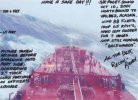
- Joined
- Jun 21, 2018
- Messages
- 1,587
That tells is all. Thats how it looks in a bad storm. What you dont see is that often the front (Bow) will go underwater. This ship has a Focle Head on the bow-that provides "reserve boyancy". Lots of tankers dont have raised bows like that. Mostly because it adds a few million to the capital building cost. In a case like this one, sometimes you can go damage the internal structure if you push her too hard. This one is a small tanker, I belive about 50KDWT. Interesting 65 RPMs seems a bit high to me, but might be right. ECO speed in good Wx would be about 65 as well. Note the white railings running up the center line...thats call a catwalk, probably 10 or 12 feet above the main deck. In Wx like this, it would be very dangerous to be on that catwalk for sure. Im familiar with this class ship...not a good handling ship in heavy wx. Note Left full rudder. She was underpowered and I believe the rudder was undersized.It depends on the movement of the storm relative to your ship.. If it was me in that weather and you asked me that question.. I would probably answer 'too long'..
A friend and classmate of mine that worked on tankers for EXXON [Sea River Maritime] sent me this photo he got from a colleague.. This is the tanker SEA RIVER PUGET SOUND in dirty weather in the Gulf of Alaska.. I have no idea who Recon Randy is, but I'm pretty sure after going through and surviving what you see in the picture, he said a prayer of thanks to the Man upstairs.. Yeehaw!
View attachment 7975

